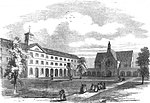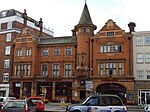190 New King's Road
Grade II listed buildings in the London Borough of Hammersmith and FulhamGrade II listed houses in LondonHouses in the London Borough of Hammersmith and FulhamLondon building and structure stubsNew King's Road ... and 2 more
Residential buildings completed in the 18th centuryUse British English from February 2018

190 New King's Road, also known as Jasmine House, is a Grade II listed house on New King's Road, Fulham, London, built in the late 18th century.It is mentioned by Pevsner as a "late Georgian detached villa, with pretty enriched cornice and doorcase."
Excerpt from the Wikipedia article 190 New King's Road (License: CC BY-SA 3.0, Authors, Images).190 New King's Road
New King's Road, London Parson's Green (London Borough of Hammersmith and Fulham)
Geographical coordinates (GPS) Address Nearby Places Show on map
Geographical coordinates (GPS)
| Latitude | Longitude |
|---|---|
| N 51.470152 ° | E -0.208398 ° |
Address
Putney Bridge Station / Fulham High Street
New King's Road
SW6 4PA London, Parson's Green (London Borough of Hammersmith and Fulham)
England, United Kingdom
Open on Google Maps











